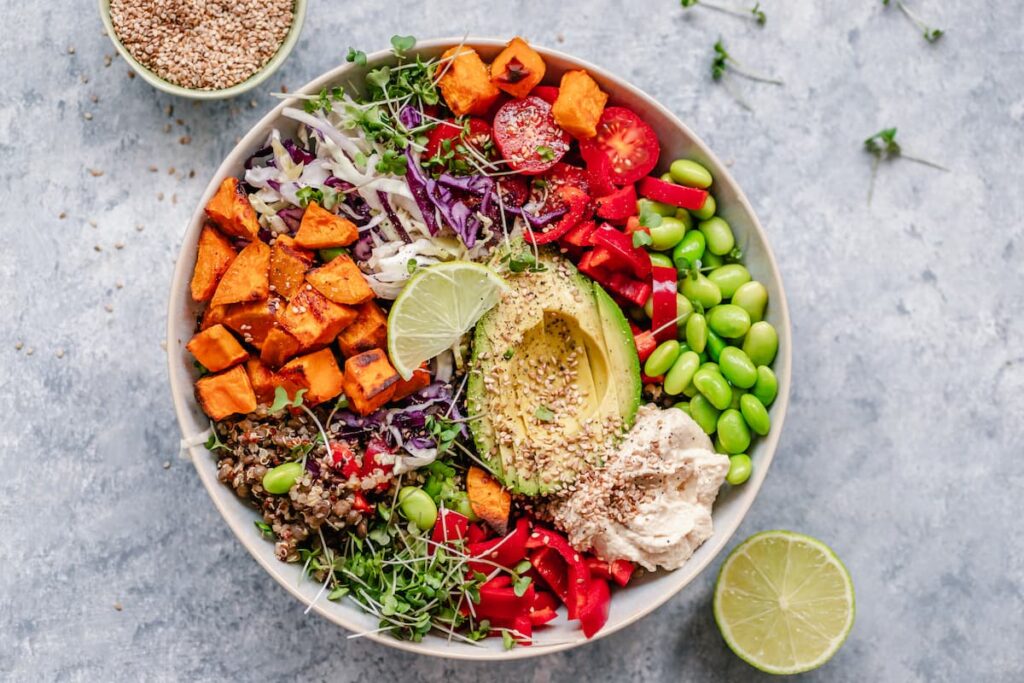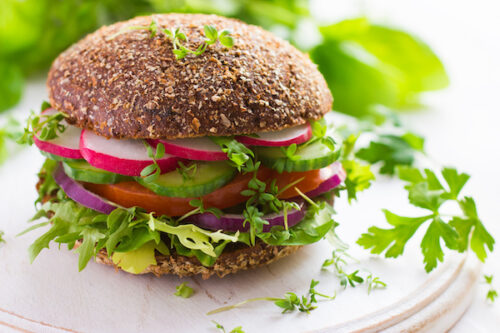Plant-Based on a Budget: How to Make Cheap Yet Tasty and Healthy Meals
Updated November 6, 2023

Although many believe choosing a plant-based lifestyle means spending more money on food, that’s not necessarily true. If you’re willing to purchase individual ingredients rather than pre-made food items, you can eat plant-based on a budget while enjoying the benefits that come with this lifestyle change.
If you aren’t sure what you should buy, what a meal plan is or how to incorporate plant-based items into your diet, keep reading to learn more about eating a plant-based diet on a budget.
Budget-Friendly Plant-Based Staples
You can start your efforts of enjoying a plant-based diet on a budget by stocking up on staples. For example, buy fresh fruits and veggies when in-season, as they’re cheaper than off-season ones. When you want off-season produce, head to the freezer section for frozen fruit and vegetable options.
Another way to save money is by buying in bulk in a smart way. Choose non-perishable plant-based staples that won’t spoil, giving you time to use them all. Examples include:
- Beans (dried and canned)
- Vegetable or non-meat broth
- Flour
- Herbs
- Lentils
- Nuts
- Oats
- Pasta
- Rice
- Seeds
- Spices
Grab these items when they’re on sale to keep costs under control.
You can pick up tofu and tempeh, although these products are perishable. If you’re buying in bulk, freeze whatever you won’t use within a week so it doesn’t spoil.
How Meal Planning Saves Money and Time
Meal planning may not sound like the most exciting thing to do with your free time, but creating and executing one can save a lot of money. When you plan your meals, you’re less likely to spend extra money on food you don’t need, like takeout or spontaneous purchases from the grocery store. Planning also helps reduce food waste as you can use the items on your list while they’re fresh.
By planning meals ahead of time, you create a grocery list without thinking too hard about what to include. Additionally, it’s worth looking at what you already have in your pantry and refrigerator to avoid buying more than you need. Use some of those staples you stocked up on by making multiple meals with them, including make-ahead freezer meals.
As you consider how to create vegan meals on a budget, think about how much you could save at every grocery store visit. If you’re reducing your bill by $30 a week, that amounts to more than $1,560 in a year.
Plan Large Meals to Store Later
In today’s world, it’s easy to get busy, making the thought of prepping a meal less appealing. This is just one reason fast food is so popular—it’s easy to grab and go when managing a busy lifestyle. But you can say no to the drive-thru by taking some steps in advance.
The solution is known as batch cooking, or preparing a large batch of a recipe and splitting it into smaller portions for consumption in the future. For example, you could make a big batch of your favorite plant-based soup or stew and portion it into portion-sized containers. Place those in your freezer, and you’ll have a quick and easy meal that simply needs to be heated up whenever you’re hungry.
You can also use this method to extend meals you already made. Maybe you’re sick of eating the meals you’ve made for one week but don’t want to waste the food. You can simply put the extra portions into the freezer, creating “emergency” meals for the days when you have no energy and just want to pop something in the microwave.
Depending on the recipe, you may need to double it when prepping so there’s enough to have multiple portions left over.
Repurpose Leftovers Strategy
After a while, eating the same food repeatedly can get boring. Instead of letting things go bad and wasting food, try repurposing items from meals you’ve already made. This process doesn’t need to be complicated—it could be as simple as mixing two leftovers together. For example, if you have leftover vegetables and noodles, combine them to create stir fry.
Do you have some leftover bread you don’t know what to do with? Cut it into cubes and roast it in the oven to make croutons that will taste great in your salad. Have a variety of veggies or fruits? Toss them into the blender to create fresh smoothies, adding a handful of seeds for added flavor and nutrients.
With so many options, you can keep your menu plans interesting while avoiding food waste. All it takes is time each week to look at what will go bad and what recipes you can use the items in right away.
Vegan Grocery List on a Budget
When you create your grocery list for vegan meals on a budget, focus only on staples, things on sale or that you have coupons for and what you need to create the meals for the week. It’s also important to forget about brand loyalty when trying to save money. In terms of quality, generic-brand goods are typically about the same as brand-name goods, while the price can be much lower.
If possible, consider purchasing items from local farmer’s markets or farms. By buying directly from the source, you may get better prices on fresh produce and other products.
Affordable Plant-Based Recipes
Create your plant-based diet on a budget meal plan with these recipes from the McDougall Program. As you make your weekly plan, consider which fruits and veggies are in season and choose dishes that include them to keep costs down.
Breakfast
- Almond French Toast
- Baked Oatmeal with Apples and Raisins
- Breakfast Apple Rice
- Breakfast Bean Burrito
- Breakfast Rice
- Cinnamon Crunch Granola
- Hash Browns
- Quick Steel-Cut Oats with Blueberry Topping
- Scrambled Tofu
Lunch/Dinner
- 3 Bean Mole
- Asian Marinated Tofu
- Baja White Bean Stew
- Baked Mexican Pasta
- Barbecue Bean Sloppy Joes
- Bean and Corn Enchiladas
- Beans and Greens
- Bean and Rice Salad
- Beetroot Hummus Veggie Wraps
- Black Bean Chili
- Brown Lentil Soup
- Cheezy Baked Macaroni
- Crockpot Pizza Potatoes
- Curried Split Pea Soup
- Easy Mexican Pasta
- French Lentil Salad
- Garbanzo Stew
- Grilled Portobello Burger
- Heather’s Pasta and Fagioli
- Macaroni Salad
- Marinara with Zucchini Noodles
- Mexican Bean Burritos
- One Pot Pasta Jumble
- Plant-Based Pizza Recipe
- Peanutty Tofu Lettuce Cups
- Sloppy Lentil Joes
- Tofu Fried Rice
- Vegan BBQ Beans With Greens
Snack/Dessert
- Baked Potatoes
- Baked Rice Pudding
- Baked Yams
- Banana Nut Bread
- Blueberry Muffins
- Cashew Ice Cream
- Cornbread
- Chubby Chips
- Oat Bars
- Oatmeal Cookies
- Quinoa Pudding
- Roasted Garlic Bread
- Squash Fries
- Tortilla Chips
- Whole Wheat Biscuits
Miscellaneous
You can also find recipes for dips, spreads, dressing and sauces, which can add flavor and texture to help make your budget-friendly, plant-based diet more enjoyable.
Health Doesn’t Have to Have a High Cost
As you can see, it’s certainly possible to go plant-based on a budget. A vegan diet can be affordable and simple with some planning, a little organization and a willingness to get creative with meals.
If you want more meal ideas, subscribe to access additional recipes. You can also explore additional resources for following a plant-based diet.
Recommended Articles

Dining Out

Plant-Based Recipes for a Busy Lifestyle






